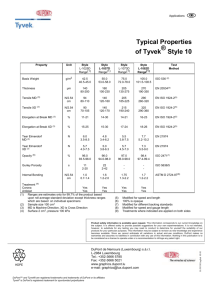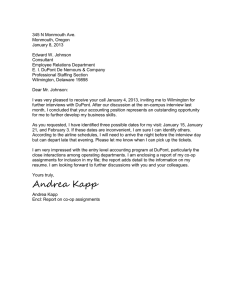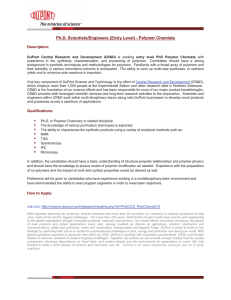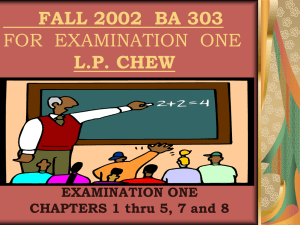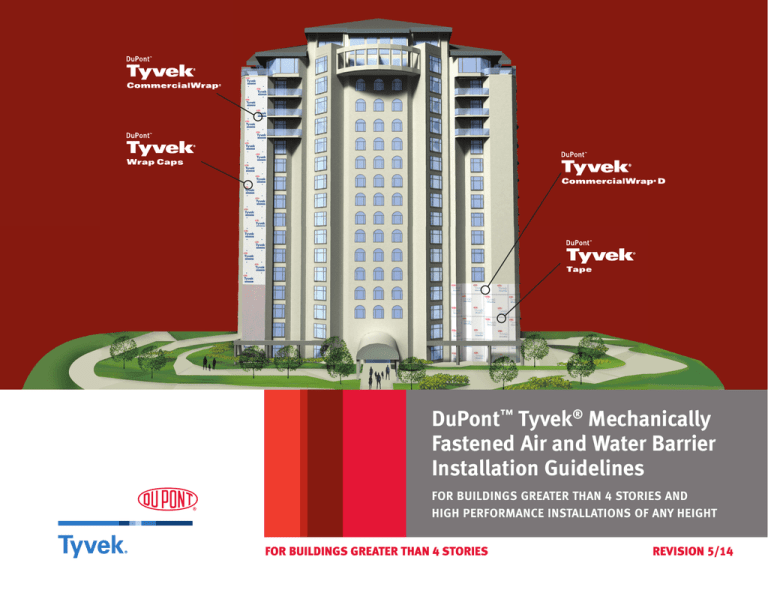
DuPont™ Tyvek® Mechanically
Fastened Air and Water Barrier
Installation Guidelines
FOR BUILDINGS GREATER THAN 4 STORIES AND
HIGH PERFORMANCE INSTALLATIONS OF ANY HEIGHT
FOR BUILDINGS GREATER THAN 4 STORIES
REVISION 5/14
DuPont™ Tyvek® Mechanically Fastened Air and Water Barrier Installation Guidelines
Table of Contents
Note
Applicable Products .......................................................................................................... 4
This installation guideline outlines recommended installation techniques and details for
DuPont™ Tyvek® CommercialWrap and/or DuPont™ Tyvek® CommercialWrap D, referred
to in this document as DuPont™ Tyvek® air and water barriers and where applicable,
DuPont™ self-adhered flashing products.
Warranty ........................................................................................................................... 4
Weather Barrier & Energy Conservation Codes and Standards ....................................... 4
Special Considerations ..................................................................................................... 5
Key Installation Requirements for Wraps Under the
Limited Product and Labor Warranty ................................................................................ 6
Installation Instructions..................................................................................................... 7
Continuity ......................................................................................................................... 8
Terminations ..................................................................................................................... 8
Penetrations ................................................................................................................... 12
Recommended Fasteners and Spacing .......................................................................... 13
Temporary Fastening ...................................................................................................... 13
Alternate Fastening ........................................................................................................ 14
Handling Tears and Holes ............................................................................................... 15
Facade/Exterior Considerations ...................................................................................... 15
Brick ........................................................................................................................... 15
EIFS ........................................................................................................................... 15
Exterior Insulation ...................................................................................................... 15
Stucco ........................................................................................................................ 16
Metal Panel ................................................................................................................ 16
Stone Veneer ............................................................................................................. 16
Wood Siding .............................................................................................................. 16
Fiber Cement Siding .................................................................................................. 16
Copyright ©2014 E. I. du Pont de Nemours and Company. All Rights Reserved. Rev. 05/14
3
DuPont™ Tyvek® Mechanically Fastened Air and Water Barrier Installation Guidelines
Applicable Products
Warranty
Air and Water Barriers
Please refer to the DuPont Weatherization Products 10-Year Limited Warranty for
Buildings Greater Than 4 Stories. For buildings less than 5 stories, and low-rise
multi-family buildings less than 6 stories, please refer to the DuPont Weatherization
Products 10-Year Limited Warranty for Buildings Less Than 5 Stories and Low-Rise
Multi-Family Residential Buildings Less Than 6 Stories.
PRODUCT
DIMENSIONS
AREA
DuPont™ Tyvek® CommercialWrap®
5 ft x 200 ft
10 ft x 125 ft
1,000 sq ft
1,250 sq ft
DuPont™ Tyvek® CommercialWrap® D
5 ft x 200 ft
10 ft x 125 ft
1,000 sq ft
1,250 sq ft
Installation Accessories
PRODUCT
™
®
™
®
TYPE
QUANTITY
3” Bulk Pack
24 Rolls/Case
2” Wrap Cap Screw
1,000 Caps/Box
DuPont Tyvek Tape
DuPont Tyvek Wrap Caps
Self-Adhered Flashing Products
PRODUCT
Weather Barrier & Energy Conservation Codes and Standards
The 2012 International Building Code (Section 1403.2 Weather Protection) requires that
“exterior walls shall provide the building with a weather resistant exterior wall envelope.
The exterior wall envelope shall be designed and constructed in such a manner as to
prevent the accumulation of water within the wall assembly by providing a water-resistive
barrier behind the exterior veneer, as described in Section 1404.2, and a means for
draining water that enters the assembly to the exterior. The exterior wall envelope shall
include flashing, as described in Section 1405.4.” DuPont™ Tyvek® Weatherization System
products have been tested to the following standards:
DIMENSIONS
AREA
DuPont FlexWrap NF
6 in x 75 ft
9 in x 75 ft
37.50 sq ft
56.20 sq ft
DuPont™ StraightFlash™
4 in x 150 ft
9 in x 125 ft
50 sq ft
93.75 sq ft
DuPont™ StraightFlash™ VF
6 in x 125 ft
62.5 sq ft
• ASTM E 1677 Standard Specification for an Air Retarder (AR) Material or System for
Low-Rise Framed Building Walls
DuPont™ Flashing Tape
4 in x 75 ft
6 in x 75 ft
9 in x 75 ft
25 sq ft
37.5 sq ft
56.25 sq ft
• ASTM E 331 Standard Test Method for Water Penetration of Exterior Windows,
Skylights, Doors, and Curtain Walls by Uniform Static Pressure
™
™
Required Materials Based on Project Requirements, Details,
and Specifications*
PRODUCT
DuPont™ Adhesive/Primer
Sealant*
• ABAA Evaluated
• ASTM E 2357 Standard Test Method for Determining Air Leakage of Air Barrier
Assemblies
• ASTM E 2178 Standard Test Method for Air Permeance of Building Materials
• ASTM E 283 Standard Test Method for Determining Rate of Air Leakage Through
Exterior Windows, Curtain Walls and Doors Under Specified Pressure Differences
Across the Specimen
• ASTM E 2556 Standard Specification for Vapor Permeable Flexible Sheet WaterResistive Barriers Intended for Mechanical Attachment
• ASTM E 84 Standard Test Method for Surface Burning Characteristics of Building
Materials
*Apply per manufacturers’ guidelines. For non DuPont products, DuPont assumes no liability in use of
recommended products; installers need to evaluate suitability of recommended products in their end-use
applications.
Copyright ©2014 E. I. du Pont de Nemours and Company. All Rights Reserved. Rev. 05/14
• NFPA 285 Standard Fire Test Method for Evaluation of Fire Propagation
Characteristics of Exterior Non-Load-Bearing Wall Assemblies Containing
Combustible Components
4
DuPont™ Tyvek® Mechanically Fastened Air and Water Barrier Installation Guidelines
Energy Conservation Codes for commercial buildings are being adopted in many regions
across the U.S. DuPont™ Tyvek® mechanically-fastened air and water barrier products
meet the following codes and guidelines.
• ASHRAE 90.1 Model Energy Code air barrier requirements
• 2012 International Energy Conservation Code® (IECC)
• 2012 International Green Construction Code™ (IgCC)
• Minnesota Commercial Energy Code, Section 1323.0543, Section 5.4.3
• Massachusetts State Building Code 780 CMR 120.AA
• Wisconsin Building Code, Energy Conservation, Chapter Comm 63
• Michigan Building Code
• Rhode Island Building Code
• Georgia Building Code
• Florida Building Code
The DuPont™ Tyvek® mechanically-fastened air and water barriers meet the ICC-ES
AC-38 Water-Resistive and Air-Barrier requirements as listed in the following code
reports.
ICC-ES Evaluation Report ESR-2375:
• DuPont™ Tyvek® CommercialWrap®
• DuPont™ Tyvek® CommercialWrap® D
Special Considerations
1. High performance installations are defined as building envelope design
requirements that exceed ASTM E1677, 65 mph equivalent structural load and
15 mph equivalent wind-driven rain water infiltration resistance.
2. DuPont™ Tyvek® CommercialWrap® D shall be installed with the grooves going up
and down.
3. DuPont requires that DuPont™ Tyvek® CommercialWrap® and DuPont™ Tyvek®
CommercialWrap® D be covered within nine (9) months (270 days) of its
installation.
4. No surface preparation is needed for the installation of DuPont™ Tyvek® air and water
barriers.
5. Adverse weather conditions or cold temperatures may require use of a primer to
promote adhesion of DuPont™ self-adhered flashing products to most common
building materials. Concrete, masonry, and fiber faced exterior gypsum board
require the use of DuPont™ Adhesive/Primer.
6. DuPont™ self-adhered flashing products perform best when installed at
temperatures above 25°F (–4°C).
7. Before applying 3” DuPont™ Tyvek® Tape, surfaces should be dry and clean. During
installation apply firm, even pressure with hand or “J” roller.
8. 4” DuPont™ Flashing Tape is an alternative to 3” DuPont™ Tyvek® Tape where
specified in the DuPont™ Tyvek® Air and Water Barrier Installation Guidelines for
Buildings Greater Than 4 Stories.
9. When high performance installations are required, DuPont™ StraightFlash™, DuPont™
Flashing Tape or DuPont recommended alternate shall be used at terminations and as
patches behind fastening plates (brick tie base plates, metal fastening clips, metal
channels, etc.)
10. Fluid applied membrane products must not come in contact with DuPont™ Tyvek®
mechanically fastened air and water barriers due to potential impact on performance
properties. Refer to the DuPont™ Tyvek® Fluid Applied WB - Commercial Installation
Guidelines for transitions to DuPont™ Tyvek® mechanically fastened air and water
barriers.
For additional guidance, please call 1-800-44-Tyvek (800-448-9835), visit our website at
www.Weatherization.Tyvek.com, or consult your local DuPont™ Tyvek® Specialist.
Copyright ©2014 E. I. du Pont de Nemours and Company. All Rights Reserved. Rev. 05/14
5
DuPont™ Tyvek® Mechanically Fastened Air and Water Barrier Installation Guidelines
Key Installation Requirements for Wraps Under the
Limited Product and Labor Warranty
Continuity
It is important to maintain the continuity of the air and water barrier throughout the
building envelope. The entire wall surface shall be wrapped, including unconditioned
spaces. Special attention should be given to ensure a proper 6’’ overlap at all
terminations, seams, penetrations, and transitions to maintain a continuous downward
drainage plane and air and water barrier. Installing the DuPont™ Tyvek® air and water
barrier as an air barrier is the preferred installation method, but when the DuPont™
Tyvek® air and water barrier is being installed as a water-resistive barrier only (Buildings
under 5 stories l Low-rise multi-family residential buildings less than 6 stories), then
skip-taping terminations and untaped horizontal seams are allowed. All vertical seams
must be taped for both air barrier and water-resistive barrier installations.
Penetrations
Seal the DuPont™ Tyvek® around all penetrations (electrical, HVAC and plumbing, etc.)
with the appropriate DuPont™ self-adhered flashing product, DuPont™ Tyvek® Tape, or
sealant. Products that have flanges should be integrated into the air and water barrier.
DuPont™ StraightFlash™ or DuPont recommended alternate patches should be applied
behind fastening plates (brick tie base plates, metal fastening clips, metal channels,
etc.) when building envelope design requirements exceed ASTM E1677, 65 mph
equivalent structural load and 15 mph equivalent wind-driven rain water infiltration
resistance.
Sealant
Review the sealant manufacturers’ literature or label to confirm that the products used
have the chemical and adhesive properties necessary for use with DuPont™ Tyvek® air
and water barriers and DuPont flashing materials. Refer to Chemical Compatibility of
Representative Building Sealants (K-27282) for more information about chemical
compatibility.
Fasteners
Use DuPont™ Tyvek® Wrap Cap Fasteners or DuPont recommended alternates per the
fastening schedule included in this installation guideline. Temporary fasteners should
not be relied upon to permanently attach DuPont™ Tyvek® air and water barriers, due to
the limited holding power of these fastening methods. If temporary fasteners are used,
permanent fastening must be applied as soon as practically possible in order to maintain
the integrity and performance of the DuPont™ Tyvek® air and water barrier and to be in
compliance with DuPont Installation Guidelines if making a claim under the DuPont
Product and Labor Warranty. Refer to page 13-14 of this document for more complete
fastening information. Examples of recommended fasteners include:
RECOMMENDED FASTENERS
• DuPont™ Tyvek® Wrap Cap 2” plastic cap screws (for steel or wood frame
construction)
• 1-1/4” metal gasketed washers with screws (for steel frame construction)
• 2” metal gasketed washers with screws (for steel frame construction)
• Tapcon® fasteners with 2’’ plastic caps (for masonry construction)
Overlap
Ensure proper shingling with a 6’’ minimum overlap of air and water barrier components
from the bottom to the top of the wall to help facilitate proper drainage.
Copyright ©2014 E. I. du Pont de Nemours and Company. All Rights Reserved. Rev. 05/14
Special Considerations
Refer to page 18 for technical specifications such as UV exposure, compatibility with
other materials, surface burning characteristics, etc.
6
DuPont™ Tyvek® Mechanically Fastened Air and Water Barrier Installation Guidelines
Installation Instructions
STEP 1
A. Starting at a corner of the building unroll DuPont™ Tyvek® air and water barrier keeping the roll plumb. Extend
approximately 12” past either the inside or outside corner of the wall.
B. Vertically overlap the next sheet of DuPont™ Tyvek® by at least 6”. Vertical grid lines have been provided
every 8” on DuPont™ Tyvek® CommercialWrap® to assist in alignment with stud spacing.
4
NOTE: It is important that proper shingling is maintained. DuPont™ Tyvek® air and water barriers should be
installed from the bottom of the building up to ensure proper shingling.
NOTE: Vertical installation of DuPont™ Tyvek® CommercialWrap® is acceptable. 6” overlap and proper
shingling of vertical and horizontal seams is required. This installation is not permitted for DuPont™ Tyvek®
CommercialWrap® D.
6”
STEP 2
The DuPont™ Tyvek® air and water barrier should overlap through wall flashing by a minimum of 6”.
Terminate the DuPont™ Tyvek® air and water barrier at the bottom of the wall with 3” DuPont™ Tyvek® Tape,
or DuPont™ self-adhered flashing products.
STEP 3
Secure DuPont™ Tyvek® air and water barrier by fastening into the studs. For fastener type and spacing refer
to the “Recommended Fasteners and Spacing” section of this document.
NOTE: In order to keep DuPont™ Tyvek® air and water barrier from being damaged by cladding installation,
special attention should be taken to ensure that the product is pressed tightly into any inside corners before
fastening.
STEP 4
Unroll the DuPont™ Tyvek® air and water barrier directly over windows and doors rough openings. Upper
layer of DuPont™ Tyvek® should overlap bottom layer of DuPont™ Tyvek® by a minimum of 6”. Do not install
fasteners within 6” of the sills and jambs of the openings and within 9” of the head of the openings.
DuPont™ Tyvek® will be fastened during flashing installation. Refer to the DuPont Self-Adhered Flashing
Systems Installation Guidelines for Buildings Greater Than 4 Stories to prepare window and door openings.
9”
1B
4
4
6”
5
1A
3
5
2
STEP 5
Tape all horizontal and vertical seams with 3” DuPont™ Tyvek® Tape.
STEP 6
After the air and water barrier is installed, refer to the DuPont Self-Adhered Flashing Systems Installation
Guidelines for Buildings Greater Than 4 Stories to prepare and flash windows and doors.
Copyright ©2014 E. I. du Pont de Nemours and Company. All Rights Reserved. Rev. 05/14
7
DuPont™ Tyvek® Mechanically Fastened Air and Water Barrier Installation Guidelines
Continuity
Terminations
It is important to maintain the continuity of the air and water barrier from top to bottom
with proper shingling. The entire wall surface shall be wrapped, including unconditioned
spaces.
Through Wall Flashing
A. Install through wall flashing on the vertical wall per plans and specifications. The
through wall flashing may be terminated by using a reglet, counterflashing,
termination bar or by embedding in a mortar joint.
Special attention should be given to all terminations and transitions to ensure a proper
drainage plane and a continuous air and water barrier is maintained.
B. Overlap through wall flashing with DuPont™ Tyvek® air and water barrier by 6”.
For high performance installations, for areas of extreme exposure and to exceed ASTM
E1677, install mechanical fasteners through the DuPont™ Tyvek® air and water barrier
terminated at the base of the wall. Use appropriate
fastener for each substrate.
C. Mechanically fasten bottom of the air and water barrier through top of through wall
flashing.
D. Seal vertical and horizontal seams using 3” DuPont™ Tyvek® Tape or a DuPont™
self-adhered flashing product.
Overlap DuPont™ Tyvek® air
and water barrier by at least
m)
0m
6” (150mm)
5
(1
6”
Overlap
through wall
flashing by
6” (150 mm)
6”
Through wall
flashing
Copyright ©2014 E. I. du Pont de Nemours and Company. All Rights Reserved. Rev. 05/14
m)
0m
5
(1
Use DuPont™ Tyvek® Tape or DuPont™
self-adhered flashing products to terminate
DuPont™ Tyvek® air and water barrier
8
DuPont™ Tyvek® Mechanically Fastened Air and Water Barrier Installation Guidelines
Shelf Angles
A. Through wall flashing should be applied to the top of the shelf angle and the DuPont™
Tyvek® air and water barrier should be properly shingled over by at least 6”.
Concrete Cantilevers
Seal to concrete cantilevers using DuPont™ Adhesive/Primer and
DuPont™ self-adhered flashing products.
B. Seal the DuPont™ Tyvek® air and water barrier to the bottom of the shelf angle using
DuPont™ self-adhered flashing products.
STEP 1
C. Seal bottom of the DuPont™ Tyvek® air and water barrier to through wall flashing
using 3” DuPont™ Tyvek® Tape or a DuPont™ self-adhered flashing product.
1.) Cut and flip up
DuPont™ Tyvek® flap
2.) Prime substrates
with DuPont™
Adhesive/Primer
4.) Wrap DuPont™
FlexWrap™ NF
around cantilever
3.) Before applying DuPont™
FlexWrap™ NF, seal the
DuPont™ Tyvek® air and water
barrier to bottom of
cantilever with DuPont™
StraightFlash™
STEP 2
C
A
6”
Lap DuPont™ Tyvek®
6” (150mm) over
through wall flashing
B
Apply 4” (100mm)
DuPont™
StraightFlash™
over DuPont™
FlexWrap™ NF
Through wall
flashing
Seal bottom using a minimum
3" (75mm) width DuPont™
Tyvek® Tape or a DuPont™
self-adhered flashing product
Seal to shelf angle using DuPont™
self-adhered flashing product
Copyright ©2014 E. I. du Pont de Nemours and Company. All Rights Reserved. Rev. 05/14
9
DuPont™ Tyvek® Mechanically Fastened Air and Water Barrier Installation Guidelines
STEP 3
Concrete Column (Method 1)
A. Wrap DuPont™ Tyvek® air and water barrier around concrete column.
B. Mechanically fasten DuPont™ Tyvek® air and water barrier at recommend
spacing. (See recommended fasteners and spacing section of this document)
NOTE: Mechanically fasten DuPont™ Tyvek® air and water barrier to concrete
column if necessary to maintain recommended fastener spacing.
Flip DuPont™
Tyvek® air and water
barrier down and tape
seams using a minimum
3" (75mm) width DuPont™
Tyvek® Tape or a DuPont™
self-adhered flashing
product
Wrap DuPont™
Tyvek® air and water
barrier over concrete
column
Copyright ©2014 E. I. du Pont de Nemours and Company. All Rights Reserved. Rev. 05/14
Mechanically fasten
DuPont™ Tyvek® air and
water barrier at
recommended spacing.
Use appropriate fastener
for each substrate
10
DuPont™ Tyvek® Mechanically Fastened Air and Water Barrier Installation Guidelines
Concrete Column (Method 2)
A. Prime concrete column with DuPont™ Adhesive/Primer.
12”
Option 1
B. Cut DuPont™ Tyvek® air and water barrier at concrete column, leaving
approximately 2” overlapping column.
C. Mechanically fasten air and water barrier into studs.
D. Seal air and water barrier to concrete using DuPont™ self-adhered flashing products.
NOTE: For high performance installations, additional fasteners may be necessary to
secure DuPont™ StraightFlash™. Use appropriate fastener for each substrate.
2”
(50mm)
DuPont™ Adhesive/Primer
Option 2
DuPont™ Adhesive/Primer
Copyright ©2014 E. I. du Pont de Nemours and Company. All Rights Reserved. Rev. 05/14
11
DuPont™ Tyvek® Mechanically Fastened Air and Water Barrier Installation Guidelines
Penetrations
Seal the DuPont™ Tyvek® air and water barrier around all electrical, ductwork and
plumbing penetrations with sealant and DuPont™ Tyvek® Tape, or DuPont™ FlexWrap™
NF. Products that have flanges should be integrated into the air and water barrier using
DuPont™ Tyvek® Tape or DuPont™ self-adhered flashing products.
STEP 1
DuPont™ Tyvek® Tape should first be applied around penetration. DuPont™ Tyvek® Tape
is used to reinforce the DuPont™ Tyvek® air and water barrier. It is important that the
tape be tightly installed to the penetrating object. Next apply an adequate amount of
sealant around the penetration.
STEP 2
STEP 3
Apply sealant
around
penetration
STEP 1
Apply DuPont™
Tyvek® Tape or a
DuPont™
self-adhered
flashing product
STEP 2
Apply DuPont™
FlexWrap™ NF
around
penetration
OPTIONAL:
Tape a piece of
DuPont™ Tyvek® over
the top of the DuPont™
FlexWrap™ NF
F
™
N
p
t
Fle
x
Cut DuPont™
Tyvek® air and
water barrier
back 1" around
penetration.
STEP 3
W
ra
Cut DuPont™
Tyvek® air and
water barrier
back 1" around
penetration.
™
F
N
DuPon
™
t
Fle
x
W
ra
DuPon
™
p
Copyright ©2014 E. I. du Pont de Nemours and Company. All Rights Reserved. Rev. 05/14
12
DuPont™ Tyvek® Mechanically Fastened Air and Water Barrier Installation Guidelines
Recommended Fasteners and Spacing
™
®
• DuPont Tyvek Wrap Cap 2” plastic cap screws (for steel or wood
frame construction)
Temporary Fastening
• Tapcon® fasteners with 2’’ plastic caps (for masonry construction)
Selection and use of temporary fastening methods is an option dependent on building
schedule, cladding options, and local building practices. Temporary fasteners should not
be relied upon to permanently attach DuPont™ Tyvek® air and water barriers due to the
limited holding power of these fastening methods. If temporary fasteners are used,
permanent fastening should be applied as soon as practically possible in order to
maintain the integrity and performance of the DuPont™ Tyvek® air and water barrier.
Table 1 – DuPont™ Tyvek® Air and Water Barrier with
Screw Fasteners and 16” O.C. Steel Stud Spacing
Temporary fastening methods:
• DuPont recommended fasteners at a reduced schedule 24” to 48”.
• 1-1/4” metal gasketed washers with screws
• 2” metal gasketed washers with screws
Allowable Pressure*
• DuPont recommended adhesives applied in vertical strips at 24” to 36” spacing or
along every other stud line.
12"
90 psf
188 mph
• #4 nails with 1” plastic cap (for wood frame construction)
18"
60 psf
153 mph
• 1” plastic cap staple with leg length sufficient to achieve 5/8” penetration into wood
stud (for wood frame construction).
Washer
Size
Fastener
Spacing
2" Metal
2" Plastic
1.25" Metal
12"
70 psf
165 mph
18"
45 psf
133 mph
12"
60 psf
153 mph
18"
40 psf
125 mph
*Values presented are maximum allowable pressures. A factor of safety may
need to be applied for certain cladding systems.
Copyright ©2014 E. I. du Pont de Nemours and Company. All Rights Reserved. Rev. 05/14
• If staples without caps are used to temporarily fasten DuPont™ Tyvek® air and water
barriers to exterior sheathing, the fastening schedule must not exceed 4 per square
yard and each staple must be covered with DuPont™ Tyvek® Tape. Covering the
staples underneath a taped air and water barrier seam is acceptable.
Temporary fastening methods may not be suitable for high performance installations.
For additional guidance, please consult your local DuPont™ Tyvek® Specialist.
13
DuPont™ Tyvek® Mechanically Fastened Air and Water Barrier Installation Guidelines
Alternate Fastening
A. Standard brick tie base plates and metal plates with DuPont™ StraightFlash™,
DuPont™ Flashing Tape or DuPont recommended alternate patches behind.
B. Metal channels, horizontal z-girts, etc. with DuPont™ StraightFlash™, DuPont™
Flashing Tape or DuPont recommended alternate behind when high performance
installations are required.
C. Wood furring strips mounted vertically.
DuPont™ StraightFlash™, DuPont™ Flashing Tape or DuPont recommended alternate
not required unless the furring strips are shimmed.
NOTE:
• Additional fasteners may be needed between brick ties, and other alternate
fasteners to maintain recommended fastener spacing.
• DuPont™ StraightFlash™, DuPont™ Flashing Tape or DuPont recommended alternate
patches should be applied behind fastening plates (brick tie base plates, metal
fastening clips, metal channels, etc.) when building envelope design requirements
exceed ASTM E1677, 65 mph equivalent structural load and 15 mph equivalent winddriven rain water infiltration resistance.
A
C
Copyright ©2014 E. I. du Pont de Nemours and Company. All Rights Reserved. Rev. 05/14
14
DuPont™ Tyvek® Mechanically Fastened Air and Water Barrier Installation Guidelines
Handling Tears and Holes
Facade/Exterior Considerations
™
®
• During the course of installing the DuPont Tyvek air and water barrier, minor tears
may occur. Be sure to tape all tears. Tears can easily be covered with 3” DuPont™
Tyvek® Tape or DuPont™ self-adhered flashing products.
• Larger tears may require you to cut a piece of DuPont™ Tyvek® air and water barrier
to repair the tear. Measure and cut a piece of DuPont™ Tyvek® large enough to cover
tear by 6”. Cut above the top of the tear large enough to accommodate the patch.
Tuck patch into slit at least 6” and shingle over lower air and water barrier. Tape
along the perimeter by starting at bottom of tear and shingling the upper tape over
the bottom tape.
Tears
Holes
1
Brick
The Brick Industry Association recommends a 1” air-space in front of wood stud
construction and a 2” air-space in front of steel stud construction. Consistent with these
requirements and recommendations, DuPont™ Tyvek® air and water barriers shall be
separated from the brick veneer by a minimum 1” air-space. Window and door flashing,
and through wall flashing shall be integrated with the DuPont™ Tyvek® layer ensuring
proper shingling. For maximum moisture management and drying of the wall system
the airspace in front of the DuPont™ Tyvek® shall be vented to the exterior at the top and
bottom of the wall. Some types of brick ties can act as alternate fasteners for DuPont™
Tyvek® air and water barrier and may reduce the required number of fasteners used for
the attachment of the DuPont™ Tyvek® air and water barrier if installed as soon as
practically possible. DuPont™ self-adhered flashing products or recommended alternate
may be required for high performance installations, contact your local DuPont™ Tyvek®
Specialist for more information.
EIFS
2
DuPont™ Tyvek® air and water barriers and EIFS cladding shall be installed according to
manufacturer’s instructions and industry standards. In order to promote drainage, it is
recommended that DuPont™ Tyvek® CommercialWrap® D be installed behind the
exterior insulation. Window and door flashing, and through wall flashing shall be
integrated with the DuPont™ Tyvek® layer ensuring proper shingling. The successful
installation and performance of EIFS cladding is dependent upon the proper design and
construction of the adjacent materials and systems of the structure.
3
Exterior Insulation
2“ (50mm)
minimum
Copyright ©2014 E. I. du Pont de Nemours and Company. All Rights Reserved. Rev. 05/14
DuPont™ Tyvek® air and water barriers and exterior insulation shall be installed according
to the manufacturer’s instructions and industry standards. DuPont™ Tyvek® air and water
barriers can be installed either over the rigid exterior insulation or underneath between the
sheathing and the exterior insulation. In order to promote drainage, it is recommended
that DuPont™ Tyvek® CommercialWrap® D be used when installing the DuPont™ Tyvek®
layer between the sheathing and exterior insulation. Window flashing, door flashing, and
through wall flashing shall be integrated with the DuPont™ Tyvek® layer ensuring proper
shingling. The successful installation and performance of exterior insulation is dependent
upon the proper design and construction of adjacent materials and systems of the
structure.
15
DuPont™ Tyvek® Mechanically Fastened Air and Water Barrier Installation Guidelines
Stucco
When stucco is installed over wood-based sheathing the 2012 International Building
Code (Section 2510.6) requires “a weather-resistive barrier with a performance at least
equivalent to two layers of Grade D paper” or a layer of air and water barrier which is
separated from the stucco by an “intervening layer”. “The individual layers shall be
installed independently such that each layer provides a separate continuous plane and
any flashing (installed in accordance with Section 1405.4) intended to drain to the
water-resistive barrier is directed between the layers.” When DuPont™ Tyvek® air and
water barriers are used behind stucco they should be separated from the stucco by a
second layer of DuPont™ Tyvek® air and water barrier, a layer of Grade D building paper,
felt, rigid foam board or the paper backing of paper-backed lath. The first layer (directly
over sheathing or studs) serves as the wall system’s air and water barrier and is
integrated with window and door flashings, the weep screed at the bottom of the wall
and any through wall flashing or expansion joints. Lath shall be installed over the
intervening layer (second layer) in accordance with ASTM C1063-03 Standard
Specification for Installation of Lathing and Furring to Receive Interior and Exterior
Portland Cement-Based Plaster and applicable codes. Rigid foam board, when installed
over DuPont™ Tyvek® air and water barrier as an intervening layer, may provide
enhanced structural support to the DuPont™ Tyvek® layer and may reduce the required
number of fasteners used for the attachment of the DuPont™ Tyvek® air and water
barrier if installed as soon as practically possible. DuPont self-adhered flashing products
or recommended alternate may be required for high performance installations, contact
your local DuPont™ Tyvek® Specialist for more information.
Metal Panel
DuPont™ Tyvek® air and water barriers and metal panel cladding systems shall be
installed according to manufacturer’s instructions and industry standards. It is
recommended that DuPont™ StraightFlash™ or DuPont recommended alternate patches
be installed behind all metal installation brackets. Window and door flashing, and
through wall flashing shall be integrated with the DuPont™ Tyvek® layer ensuring proper
shingling See “Alternate Fastening” section, page 14, for additional information.
Copyright ©2014 E. I. du Pont de Nemours and Company. All Rights Reserved. Rev. 05/14
Stone Veneer
The 2012 International Building Code (Section 1405.6) requires two layers of air and
water barrier behind stone veneers over wood frame construction. When used behind
stone veneer, DuPont™ Tyvek® air and water barriers shall be installed in a similar
manner as they are installed behind stucco. DuPont™ Tyvek® air and water barriers
should be separated from the stone and mortar by a second layer of DuPont™ Tyvek® air
and water barrier, a layer of grade D building paper, felt, rigid foam board or the paper
backing of paper-backed lath. The first layer (directly over sheathing or studs) serves as
the wall system’s air and water barrier and shall be integrated with window and door
flashings, the weep screed at the bottom of the wall and any through wall flashing or
expansion joints. Lath shall be installed over the intervening layer (second layer) in
accordance with ASTM C1063-03 Standard Specification for Installation of Lathing and
Furring to Receive Interior and Exterior Portland Cement-Based Plaster and applicable
codes. DuPont self-adhered flashing products or recommended alternate may be
required for high performance installations, contact your local DuPont™ Tyvek® Specialist
for more information.
Wood Siding
DuPont™ Tyvek® air and water barriers and wood siding shall be installed according to
manufacturer’s instructions, industry standards and applicable codes. As recommended
by the Western Red Cedar Lumber Association and U. S. Forest Product Laboratory,
wood siding should be primed on all six sides before installation. In high exposure
installations, enhanced drainage and water management may be provided by using
DuPont™ Tyvek® CommercialWrap® D or by creating rainscreen cladding with a larger
airspace behind the siding using furring strips. See “Alternate Fastening” section, page
14, for additional information.
Fiber Cement Siding
DuPont™ Tyvek® air and water barriers and fiber cement siding shall be installed
according to manufacturer’s instructions and industry standards. In high exposure
installations, enhanced drainage and water management may be provided by using
DuPont™ Tyvek® CommercialWrap® D or by creating rainscreen cladding with a larger
airspace behind the siding using furring strips. See “Alternate Fastening” section, page
14, for additional information.
16
DuPont™ Tyvek® Mechanically Fastened Air and Water Barrier Installation Guidelines
PROPER OVERLAP FOR WATER MANAGEMENT
A. Lap all components from bottom of the wall to the top of the wall
B. Treat the walls of the building just like a roof
Roofing Material
Note: In order to make a claim under the DuPont 10-Year Limited Product and Labor
Warranty on DuPont Weatherization Products, you must have met all of the terms and
conditions of the warranty, including use of the applicable DuPont Installation
Guidelines. In the event that a specific detail or installation technique is not covered in
the DuPont Installation Guidelines at the time you are building, then the Key Installation
Requirements outlined in this document must have been followed in order to make a
claim under the warranty. Compliance prior, during and post construction with the Key
Installation Requirements are at the sole discretion of DuPont. Please contact DuPont or
a DuPont™ Tyvek® Specialist if you have any questions in connection with any DuPont
Installation Guideline.
Sheathing
Air and Water
Resistive Barrier
Through Wall
Flashing
Copyright ©2014 E. I. du Pont de Nemours and Company. All Rights Reserved. Rev. 05/14
17
Technical Specifications
™
®
DuPont Tyvek air and water barriers used in construction products are made from 100% flash
spunbonded high density polyethylene fibers which have been bonded together by heat and
pressure, without binders or fillers, into a tough durable sheet structure. Additives have been
incorporated into the polyethylene to provide ultraviolet light resistance. DuPont requires that
DuPont™ Tyvek® CommercialWrap® and CommercialWrap® D be covered within nine (9) months
(270 days) of installation.
DuPont™ DuPont™ self-adhered flashing products are made from a synthetic rubber adhesive and a
laminate of polyethylene film, polypropelene film, elastic fiber, synthetic rubber adhesive,
polyurethane adhesive, and a top sheet of flash spunbonded high density polyethylene fibers or
polypropelene film. Additives have been incorporated into these materials to provide ultraviolet light
resistance. DuPont requires that DuPont™ FlexWrap™ NF, StraightFlash™ and StraightFlash™ VF be
covered within nine months (270 days) of installation. DuPont requires that DuPont™ Flashing Tape
be covered within four months (120 days) of installation.
Warning
DuPont™ Tyvek® air and water barriers are slippery and should not be used in any
application where they will be walked on. In addition, because they are slippery, DuPont
recommends using kickjacks, scaffolding, or lifts for exterior work above the first floor. If
ladders must be used, extra caution must be taken to use them safely by following the
requirements set forth in ANSI Standards 14.1, 14.2, and 14.5 for ladders made of wood,
aluminum, and fiberglass, respectively. DuPont™ Tyvek® is combustible and should be
protected from flames and other high heat sources. DuPont™ Tyvek® will melt at 275°F
(135°C) and if the temperature of DuPont™ Tyvek® reaches 750°F (400°C), it will burn and the
fire may spread and fall away from the point of ignition. For more information, call
1-800-44-Tyvek.
Note
When installed in conjunction with other building materials, DuPont™ self-adhered flashing products
must be properly shingled with these materials such that water is diverted to the exterior of the
wall system. DuPont™ Tyvek® products are air and water barriers and not the primary water barrier.
The outer facade is the primary barrier. You must follow facade manufacturer’s installation and
maintenance requirements for all facade systems in order to maintain water holdout properties and
ensure performance of DuPont™ Tyvek®. Use of additives, coatings or cleansers on or in the facade
system may impact the performance of DuPont™ Tyvek® air and water barriers. DuPont™ Tyvek®
Weatherization Systems products are to be used as outlined in this installation guideline. DuPont™
self-adhered flashing products should only be used to seal penetrations and flash openings in
houses or buildings. DuPont™ self-adhered flashing products are not to be used in roofing
applications. For superior protection against bulk water penetration, DuPont suggests a system
combining a quality exterior facade, a good secondary air and water barrier and exterior sheathing,
high quality windows and doors, and appropriate flashing materials paying attention to proper
installation of each component. In a system where no exterior sheathing is used and DuPont™
Tyvek® air and water barrier is installed directly over the wall studs, exterior facade materials should
be selected to ensure maximum protection against water intrusion. Careful workmanship and
proper installation of each component is very important.
DuPont believes this information to be reliable and accurate. The information may be subject to
revision as additional experience and knowledge is gained. It is the user’s responsibility to determine
the proper construction materials needed.
For complete warranty information please call 1-800-44-Tyvek.
This information is not intended to be used by others for advertising, promotion, or other
publication for commercial purposes.
DuPont™ DuPont™ self-adhered flashing products and their release paper are slippery and
should not be walked on. Remove release paper from work area immediately. DuPont™
self-adhered flashing products will melt at temperatures greater than 250°F (121°C).
DuPont™ self-adhered flashing products are combustible and should be protected from
flames and other high heat sources. DuPont™ self-adhered flashing products will not support
combustion if the heat source is removed. However, if burning occurs, ignited droplets may
fall away from the point of ignition. For more information, call 1-800-44-Tyvek.
Copyright ©2014 E. I. du Pont de Nemours and Company. All Rights Reserved. Rev. 05/14
18
For more information about DuPont Weatherization
Systems, please call 1-800-44-Tyvek or visit us at
www.Weatherization.Tyvek.com
Copyright © 2014 E. I. du Pont de Nemours and Company. All rights reserved. The DuPont Oval Logo, DuPont™, Tyvek®, CommercialWrap®, FlexWrap™, and StraightFlash™, are registered trademarks or trademarks of DuPont or its affiliates. Tapcon® is a registered trademark of ITW Buildex. All
rights reserved. K-16160 5/14

